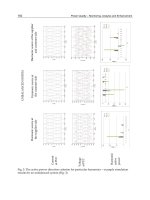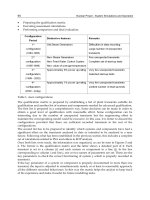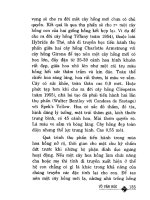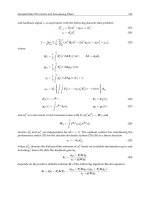Bees And Honey - Part 8 pdf
Bạn đang xem bản rút gọn của tài liệu. Xem và tải ngay bản đầy đủ của tài liệu tại đây (430.77 KB, 15 trang )
Queen rearing
We have stressed the need to have young mated queens available at
various times during the active season: in the spring to replace a 'poor
queen' and in the swarming season to replace queens in colonies that
have made up their minds to swarm. Also at those times all through the
active season from April to the end of July when queens may suddenly
fail and need replacing, and at the end of the season when two-year-old
queens should be replaced with young ones. In other words, for many
reasons the useful length of life of queens may vary considerably and
some preparation must be made to provide replacements which are of
good quality and breeding.
With the honeybee there is a more obvious difference between the
concepts of quality and breeding than with many other animals. The
quality of a good queen with excellent inheritance can be heavily
concealed by poor nurture during her larval development. Bee
breeding is difficult and although extremely interesting may have to be
left to the beekeeper with a large number of colonies. Queen rearing,
on the other hand, can and should be practised by all beekeepers. The
queens that are to be used in the apiary should be the product of
thought and planning. They should not be the queens that the colony
happens to make, when it can no longer hold together with the queen it
has.
We know that the fertilized egg of the honeybee can be turned into
either a worker or a queen dependent upon how it is housed and fed.
We also know from experience and research that the best queens are
those produced in large colonies where there are lots of young bees and
plenty of pollen for them to feed on when they are making 'bee milk'.
The queen larvae are then fed to a maximum and grow large, and with
a large number of egg tubes in their ovaries. In contrast, the small
nucleus will never be able to produce a top-line queen. The nucleus is
usually struggling to build up and has as many worker larvae mouths to
feed as it can manage. To expect a number of queen cells as well is to
ask for a poorly-fed queen.
The best queens are produced from very young larvae, or eggs.
Research shows that the larva which is treated as a queen from the start
produces the heaviest queens with the highest number of egg tubes and
the largest spermatheca. It also shows that the reduction in these
factors occurs as progressively older larvae are taken for queen rearing.
Thus if we are to produce queens for use in our own apiary we should
produce them in as large a colony as possible: one in which there are
plenty of young bees to act as nurses, and ample pollen. Finally, the
worker larvae from which the queens are to be made should be as
young as possible when they are started off on their careers as queens.
The process of queen rearing can be broken down into four separate
parts: the provision of the colony which is to produce the queens,
usually called the cell-building colony; the. selection of a colony which is
to provide the larvae—this is the breeder colony and it contains the
breeder queen; the process of giving the larvae from the breeder queen
to the cell-building colony, and finally the removal of the ripe queen
cells from the cell-building colony before the first virgin queen hatches
(or she will kill all the rest) and the placing of these queen cells into
small 'mating nuclei' from which they can fly, mate, and in which they
can start laying.
Let us look first of all at a selection of breeding stock. It would be
stupid not to take advantage of the process of queen production to
increase the value of our stock as much as possible. Bad characteristics
which can easily be recognized can be bred out very quickly, and these
include stinging, following and excessive running about on the comb
when being manipulated, all separately inherited and tiresome.
Running about on the comb can be so bad that when combs are lifted
from the hive the bees on them run down to the bottom of the combs,
form clusters and drop off. It requires little imagination to picture the
problem if this is happening when you are looking for the queen.
These characteristics should be culled from your strain of bee as
quickly as possible by avoiding producing queens from colonies which
show them, and by replacing the queen in such colonies as soon as
possible. The sooner they are gone the better, because all the while
they are there they will be producing drones which may mate with the
young queens and pass the bad traits on to future generations.
Persistent swarming is another inherited trait that can be reduced by
culling—that is by replacing those queens whose colonies show it.
Swarming is the bees' natural method of increasing the number of
colonies, or the number of sexual females, whichever way you wish to
look at it. Without swarming reproduction does not take place, and
from the point of view of the species as a whole this would reduce its
ability to withstand adverse conditions. I therefore feel that it is not
possible to envisage a useful bee from which the swarming instinct has
been entirely eliminated. It can, however, be greatly reduced, and for
this reason I would try to breed from bees which neither try to swarm
every season, nor make large numbers of queen cells when they do. I
would breed from colonies that once having made up their mind build
up to nine or ten cells, but colonies such as one I had in Devon which
produced 153 queens and queen cells at one time should be culled as
rapidly as possible.
Breeding for honey production is much more difficult because its
characteristics cannot be assessed in any meaningful way. Individual
colonies which produce very large surpluses of honey may do so for
many reasons other than the inheritance of a very high work rate. They
may just be very good robbers, and have stolen their honey from other
colonies. They may be in a position in the apiary where a lot of bees
drift in on a prevailing wind. They may always be that truly
exceptional case which has inherited genes which all add together to
give a very high production, but this is a fortuitous happening which is
not possible to repeat in the offspring. The only useful method is to
look at the family from which a queen comes before she is chosen as a
breeder. Her sisters should all be equally good and all their colonies
acceptable to the beekeeper.
You often hear it said that you should not breed from the exceptional
colony. But often this is then altered to 'you should not breed from
your best colony', which is not necessarily correct. If you have only
three or four colonies, or even a dozen, you are unlikely to have an
'exceptional' colony in your apiary. These are by definition very rare
and the chances of their turning up amongst a few hives is very small.
The beekeeper with just a few hives is best advised to breed from his
best colony. He may come unstuck once or twice in a lifetime but this is
a chance worth taking. If he has a large number of colonies then he is
best advised to breed from a queen belonging to a good family. The
beekeeper with the small number of hives can of course band together
with a number of other beekeepers and by selecting over all their
colonies practise 'family selection'—the result will be much more
successful in the long run than working alone. So much for breeder
colony selection.
The provision of the cell-building colony will depend very much on
the number of hives you are catering for and the number of queens you
wish to produce. I will therefore deal with the subject at three different
levels. One for the beekeeper with up to about ten colonies, secondly
for the man with up to fifty colonies, and finally large-scale rearers.
The small scale beekeeper will do best by deciding to work his best
colony on two brood chambers. This is the colony that is building up
most rapidly in the early season. If this colony is given a second brood
chamber of drawn combs the bees should spread up into it very
rapidly. If the colony which is to be given the second brood chamber
has an arch of honey in the top of the frames of the original brood
chamber, get them to shift this by scraping the capping with the hook
of your hive tool, thus laying bare the honey. The bees will usually
then remove the honey and take it to the top box. The colony should be
built up rapidly to as large a size as possible by the third week of May.
This date will depend upon the time at which you can safely start
queen rearing and expect to get the queens mated.
Once the colony is using most of the brood chambers add supers as
required: by the third week of May it should have at least one super, if
not two. The colony is now ready to produce queen cells, and you
should act as follows. First find the queen and place her in a match box
with a few bees to look after her. The two brood chambers can then be
sorted through. Put all the unsealed brood in one and make the box up
with sealed brood and one good frame of pollen if this available. Put
the sealed brood on the flanks—i.e. nearest the hive walls—the
unsealed brood between them and the pollen comb in the centre. The
remainder of the combs are put in the other brood chamber, the queen
freed on to one of them, and the brood chamber then replaced on the
floor on its original site. The supers are put on next above a queen
excluder, and if there is only one super at this time I would add a
second. A second queen excluder should now be placed above the
supers and the brood chamber containing the young brood placed on
top covered by the usual crown board and roof.
The young nurse bees will be drawn to the top brood chamber by the
presence of the unsealed brood, but the fact that they are isolated from
the queen by two excluders and two supers and that the full transfer of
food, and hence queen substance, will not take place between the
bottom and top brood chamber bees, means they will usually make a
small number of queen cells. In this case you are using this colony as
the breeder colony as well as for the production of cells. It may be,
however, that the queen you would like to breed from is not capable of
building up a colony large enough for the above procedure. In this case
you must insert a marked frame of eggs and very young brood taken
from the colony from which you wish to breed your queens, and
remove any queen cells produced from their own brood by the bees in
the queen-rearing colony. If you are lucky with this method and get a
satisfactory number of cells, as soon as these are ripe—about ten days
after the colony is split as described—you may either cut them out and
distribute them to mating nuclei, or the top brood chamber combs and
bees can themselves be split up into mating nuclei using some of the
queens. You will only be able to split it into about three nuclei if you
are going to have sufficient bees in each.
The second method is for the production of from twenty to forty
queens and is much more positive than the above method. In the early
season the technique is the same—a very large colony is built up on two
brood chambers. Because the beekeeper has a greater number of
colonies he can take frames of brood from colonies which are building
up well and give these to the cell-building colony, thus building it up to
a massive size. When the time for queen rearing comes the queen is
found and removed on to a small two-frame nucleus. The rest of the
colony is made up with a super at the bottom, on the floor, then a queen
excluder with a brood chamber above it. The brood chamber should be
filled with eight frames of sealed brood, one frame of unsealed brood
and a frame of pollen, the unsealed brood and pollen being placed in
the centre of the brood chamber. Assuming an eleven frame chamber
this leaves an empty place which can be filled with a dummy board.
The colony should now be given all the bees from the rest of the combs,
both brood and super. This is done by shaking them into the brood
chamber just set up, and the colony may then be given a feeder of syrup
and closed down. Any surplus brood and supers should be dispersed
amongst the other colonies—as these frames have no bees they cannot
be given to their own queen as she has not enough workers.
The main colony, now congested to overflowing and queenless, will
make queen cells. I would leave the colony for two or three days and
then remove the new queen cells in it, shaking the bees off the combs so
that none is missed, and give them a frame of larvae which are to be
turned into the queens we want from the breeder queen. These larvae
should be put in the centre of the broodnest between the frame of
young brood and the frame of pollen. Queen cells will be constructed
on this frame and will be sealed in four days, so a second batch of larvae
from the breeder queen can be given at this time if required. Cells will
be ready to be distributed ten days after the larvae are put in, so if two
batches are required the colony will be cell building for 17-18 days
from the time the queen was removed. As soon as their role of cell-
building colony is completed, the original queen in her nucleus can be
put back and the colony brought back into honey production.
The final method is for the beekeeper who requires a considerable
number of queens. It is very like the last method but involves
combining two large colonies in a special brood chamber that takes
13-15 frames. This massive colony is kept going from about the third
week in May to the end of July, and larvae for queen rearing are placed
in every three or four days. As the worker brood hatches, more is added
from other colonies and this prevents a fall in population. Such a
method can produce several hundred queens in the course of a summer
but requires a back-up of mating nuclei available in the required
quantity.
Having set up this cell-building colony, two or three days later the
whole colony is looked through and, as with method 2, any queen cells
are destroyed, and larvae from the breeder colony inserted.
Grafting
Insertion of larvae can be done in many ways but my own preference is
for the 'Doolittle' method or, as it is commonly termed, 'grafting'.
This is the process whereby a number of small waxen cups are made by
the beekeeper. These are attached to bars constructed in the usual size
frame. Small larvae are then transferred from their comb in the
breeder colony, one into each cup. These are then placed in the cell-
building colony for the queenless bees to turn into queens. I find this
method the easiest, quickest, least messy and most reliable of all the
methods generally used. This is how it is done.
The wax cups are prepared by dipping a wooden or glass former into
molten beeswax. The former can be made from 1/4 inch dowelling or
glass tubing, the ends of which are rounded off and well smoothed. If a
lot of cells are to be made a bar with a number of formers can be
dipped, giving several cups for each dipping, as drawn above. The
formers will stick to the wax unless they are wet, and for this reason
they are placed in water several minutes before use and are dipped in
again between each application. Wax is melted in a small water
bath—nothing more elaborate than a small empty meat or fruit tin
standing in an old saucepan is needed, though a special double-
jacketed trough as shown in fig. 38 can be used. The wax should be
good, clean wax and should not be heated much above melting point.
The former is then removed from the water, shaken to get rid of excess
water and dipped about five times into the molten wax to a depth of
about 5/16 inch. Some beekeepers try to dip progressively less deeply
each time to provide a thin edge to the 'cell'. I have never found that
this helps in any way and usually dip to the same level using a depth
guide on the former. The single former is dipped until the wooden
crosspiece hits the sides of the container and the multiple former has
the two bolts at the end which can be adjusted for height and which
contact the sides of the trough. After dipping, the former is placed
back in the water for a few seconds, when the cups can easily be twisted
off the ends.
The cells are fastened to bars on a frame made up as illustrated
above. The bars can be fastened to the frames in several ways but the
main thing is that they must be easy to get at when fastening the cells
on. Equally, the cells may be put on in several ways, and here the main
thing is that they must be easily removable for taking away to mating
nuclei, and should be robust enough for easy handling. The cups can
be fastened to small squares of wood, which are then stuck to the bars,
or by melting beeswax on to the wooden bars to about 1/8 inch depth
before they are stuck on, illustrated overleaf. In both cases they are
stuck on to the bars with molten beeswax. A useful tool for both
building up wax on the bars and then fastening cells to it is a teaspoon
bent in a vice as shown.
When the cells have been fastened to the bars they are ready for use.
The next thing to do is to prime them with a small quantity of dilute
royal jelly; this can be obtained from the queen cells which have to be
destroyed in the cell-building colony. The royal jelly should be diluted
until it will just drop from a matchstick or something of about that size.
An eye dropper can be used instead of a match to place the jelly in the
cells, but this should only be done a few minutes before the larvae are
to be transferred as it will soon dry up. The use of jelly is not absolutely
necessary but it is considerably easier to float the larva on to a drop of
liquid than to get it off on to the dry floor of a cell. If possible the whole
apparatus—frames, bars, cells and jelly—should be kept warm at just
over blood heat so that the larvae are not chilled. It is also
advantageous to have high humidity, and this can be easily obtained by
boiling water close on hand. Good queens can be produced in less than
ideal conditions as long as reasonable care is taken to prevent chilling.
Having got this far, the beekeeper will go to the breeder colony and
select a comb containing very young, just-hatched larvae. The bees are
brushed, not shaken, from the comb, as heavy shaking may displace
larvae and make them more difficult to pick out. The frame should be
covered with a cloth and taken to the apiary shed, or wherever the
grafting is to be done, as quickly as possible. The artificial cells are
primed with royal jelly and the selected larvae are transferred, one to
each cell, with a transferring or grafting tool, shown in fig. 39, which
can be made of stainless steel, plastic or wood. The larva should be
approached from the back (shown above) and the flat end of the tool
slipped under it so that it can be lifted. Transfer to the liquid in the cell
is easy: it is only necessary to pass the end of the grafting tool through
the drop and the little larvae will be floated off. The larvae should be
under thirty-six hours old and as small as possible—about half the size
of a lower case letter 'c' in this book. A good light is necessary to see
them and this will help to provide heat as well. The novice may find it is
easier to find a row of larvae, and then to run a warm sharp knife along
their cells, levering the bottom halfback to an angle of 45
0
so that the
larvae are easier to get at and easier to see.
As soon as the larvae have been grafted, check to see that you have
one in each cell, and covering the new frame with a cloth carry it to the
cell-building stock and place it between the unsealed brood and pollen
without delay. If a space has been left open for the graft frame, bees
will have clustered in this space and will transfer directly to the graft as
it is slowly lowered into place. If the bees do their job, these cells will
be ready for dispersal to the mating nuclei ten days after grafting.
Mating nuclei should be prepared eight days after the cells are
grafted so that they are queenless for two days before the grafted cells
are put in. This puts the nuclei into the right condition to receive cells.
The cells themselves will not be ready to hatch for two more days, so at
the time of dispersal from the cell-building colony to the mating nuclei
the queens in their cells are still quiescent, wrapped in their pupal skin.
This is the time when cells are most readily accepted by the mating
nuclei, and unlikely to be damaged by the workers. The use of queen-
cell protectors, recommend in some of the older literature, is
unnecessary.
Mating nuclei
It is the provision of bees for mating nuclei which has prevented many
beekeepers from rearing queens. They dislike breaking up colonies for
this purpose when they could be producing more honey. It is true that
you reduce honey from these colonies as well as the ones you use for
cell building. The loss will, however, be more than compensated for by
the use thereafter of good, well-nurtured queens in all your colonies.
Nor do you need to take a great deal from your colonies to make the
mating nuclei, as these can simply consist of one frame of brood and
one of stores.
Making nuclei is dealt with in Chapter 7 and the same rules and
problems arise whether the nuclei are to be used for mating or increase.
I should like to deal here with what I consider to be the most
economical method of using mating nuclei, which also covers the over-
wintering of some young queens for use in spring and early summer.
Another advantage of this system is that the nuclei are permanent and,
unless they are lost in a very bad winter, need making only the once.
The method is based upon double nucleus boxes as shown in fig. 40.
The double box uses the same frames as in the rest of the apiary: it is
therefore a normal brood chamber into which, halfway along each side
wall, is worked a groove which takes a central partition. This partition
must be fitted to the hive so that it is absolutely bee-proof between the
two nuclei. If they can contact each other, and particularly if the
queens can get at each other, only one queen per box will be the result.
To ensure they are bee-proof a floor must be permanently and securely
nailed on to the brood chamber. The central division can then be fitted
to the floor and marked so that it is always put in the same way. I would
suggest three marks to save problems. These are placed one on the
division board, for example on the top right hand corner, with a similar
mark on the side wall directly beside to locate the partition in the right
hive and the right way round. If the partition is out and the brood box
being used as a normal hive full of bees it is helpful to know which
board belongs to which hive before going to the colonies. It is best
therefore to repeat the mark a third time on the outside of the side wall
where it can be easily seen. When the partitions are in, a canvas quilt is
more convenient than a wooden crown board for each half. Fig. 40
shows the canvas quilt nailed to the top edge of the partition—handy
when opening the nucleus with one hand and carrying queen cells in
the other.
The nuclei will be made up on each side of the partition with a frame
of sealed brood next to the partition followed by a frame of stores and a
dummy or a frame feeder, as shown in fig. 41. Sufficient bees are put in
to keep the whole lot warm and, if the nuclei are being made from
colonies in the same apiary, to allow for the return to their old home of
any old bees. It is a good idea to check after one day that the nucleus
strength is adequate. Two days later the ripe queen cell will be put into
the nucleus after the beekeeper has shaken the little colony through
and removed any of their queen cells. The queen should be mated in
10-14 days if the weather is fine and from then on the little colony will
build up very rapidly. They will need more comb very soon and I
would give them foundation only as this will be pulled out beautifully
and will also hold them back somewhat from too rapid a build-up.
The number of these boxes required and the way they will be used
will depend upon the number of colonies kept by the beekeeper. One
double box in which two queens can be over-wintered should be
enough for up to about eight colonies. More queens will of course be
needed for summer requeening, but these could be mated in single
nucleus boxes, as on p. 78, the bees of which would be dispersed when
the queen is moved. In fact the entire nucleus could be used to requeen
any colony in need. The double box would be given its cells and then
built up to five frames on each side which, if well fed, should be fit to
overwinter. In good seasons these nuclei with new young queens build
up very quickly and it may be necessary to take sealed brood away to
prevent the population overflowing. The sealed brood can be given to
one of your other colonies and the bees it produces can work for you to
get honey.
For larger beekeeping enterprises the number of double boxes will
be increased pro rata, using a ratio of 1:8 to calculate the number of
double boxes needed. This ratio allows the large beekeeping enterprise
using the continuous cell-building colony to have all the mating
necessary done from these double boxes. The method here is to
remove the new queens as soon as they are laying, or as soon as their
first worker brood is capped and two days later to put another queen
cell in from the cell-building colony. In this way about three or four
queens can be mated in each nucleus during the season.
Knowing when the new queen will emerge in each nucleus, I would
look for her on that day: she is usually easy to find because she is light
in colour and fairly slow in her movements, not having had time to
'harden off. A sight of her will confirm if she is in good order, with all
the necessary legs and wings. The workers will tolerate the
examination when the queen has just emerged but after this they
become progressively more likely to kill her if the colony is disturbed.
Thus, look on the day of emergence or the following day, but
thereafter leave them alone for not less than ten days, in which time, if
the weather has been reasonable, she should have been mated and
possibly have started to lay. The tolerance of examination varies with
the strain of bee and you may find that you can look at your bees again
in under ten days, but I would say not less than six days. By looking at
the nucleus on the projected day of emergence, the cell can be
examined and the queen 'pulled' if she has not emerged, or the
contents discarded if she is anything other than a good queen.
A pulled queen will be quite all right providing she can stagger along
until she dries out and hardens. Any cell which is discarded, or any one
from which the queen has emerged and vanished, should be replaced
immediately with a queen cell from the cell-building colony. This
saves time and prevents these mating nuclei from becoming truly
queenless.
The beekeepers who do not need to use continuous cell-building
colonies (impractical unless they need about a hundred queens a
season) will probably find it most economical to scale up from the
small-scale method. That is, to do their queen rearing in three or four
successive grafts, making up nuclei to accommodate these; some in
double boxes and some in single boxes.
Double boxes are used to overwinter the last two queens mated in
them. To do this they should be built up on to five frames on each side
of the division, and each side fed down as heavily as possible with
separate feeders in August. The more bees they have, the better they
will survive the winter. If several queens are being mated in them
during the course of the season, with the frequent manipulations this
will entail, it is best to feed Fumidil 'B' in the autumn syrup (see
page 132) at least every other year. This prevents the build up of nosema
in the mating apiary (see Chapter 9).
When the next active season arrives one queen can be used from
each double box to correct weaknesses in the honey-production
colonies. The nucleus is opened, the queen removed into a travelling
cage (see page 164) with about twelve workers put in to look after her,
and in this she will be all right for a week or so, although she should be
used as quickly as possible. The easiest way to put bees into the cage
with her is to take a comb out which has honey in it on which the bees
are feeding at the time. When they have got their backs to you and their
heads in the cell they cannot see your fingers arriving and usually their
wings are neatly folded ready for picking up. If picked up by both
wings they cannot curl their tails around to sting, and can be easily
introduced into the entrance of the cage. The queen can be clipped
before she is put into the cage which makes her removal from it later so
much easier. For food a little candy should be put in the cage. 'Queen
cage candy', made by mixing ground fondant or icing sugar with
honey, is best. It should be made as stiff as possible, but this particular
candy has the advantage that it never goes rock hard, as does candy
made with water.
After the queen is removed from one side of the double box, all the
bees can be dusted with plain flour, using a flour dredger, while they
are on the combs and the central partition removed. By the time the
two little colonies have cleaned up the mess of flour they will have
become peacefully united. This colony can then be built up as a unit
until the queen rearing starts again when it will be broken up to
provide the two mating nuclei, each consisting of one frame of brood
and one of stores plus bees to cover on each side of the replaced central
division.
The colony is likely to have built up by this time so that there will be
a considerable residue of bees and brood and, of course, a surplus
queen. This surplus portion can be used in several ways. It should
normally make a nice five-frame nucleus, and this can be used to make
increase or to replace a colony lost in the winter; it might be added to a
weak colony from which the queen has to be removed, or it could be
sold. Alternatively, it can be split up into four or five mating nuclei if
these are required. This method avoids the continuous need to break
up production colonies to provide mating nuclei. In effect, the queen
rearing becomes separated from the honey-production side, with
advantages to both.
The whole process of queen rearing should be carefully recorded in
an apiary book, giving dates of making up cell-building stock,
recording each graft, with the number of cells grafted, the number
accepted and the number put out to mating nuclei. Each mating
nucleus should be recorded as to when it is made up, when queen cells
are introduced, whether virgin queen is seen, date when mated, and
date removed. In this way a complete picture of your queen rearing can
be seen, the origin and history of every queen known, and mistakes
noted and analysed so that your technique is improved over the years.
It is a great pity that more beekeepers do not practise queen rearing
enjoying the great interest and excitement which goes with it, and the
personal satisfaction of seeing a large laying queen which you have
been instrumental in producing from the time she was a small larva.









